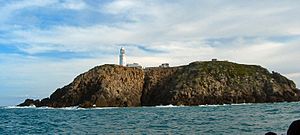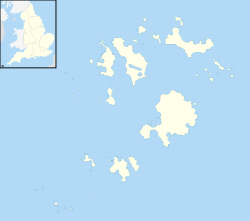Round Island Light, Isles of Scilly facts for kids
 |
|
| Round Island, Isles of Scilly | |
|
|
|
| Location | Round Island Isles of Scilly England |
|---|---|
| Coordinates | 49°58′45″N 6°19′23″W / 49.979033°N 6.323108°W |
| Year first constructed | 1887 |
| Automated | 1987 |
| Construction | granite tower |
| Tower shape | cylindrical tower with balcony and lantern |
| Markings / pattern | white tower and lantern |
| Height | 19 metres (62 ft) |
| Focal height | 55 metres (180 ft) |
| Original lens | biform hyperradial optic |
| Current lens | 360mm revolving optic |
| Intensity | 42,945 candela |
| Range | 18 nautical miles (33 km; 21 mi) |
| Characteristic | Fl W 10s. |
| Fog signal | 4 blasts every 60s. |
| Admiralty number | A0018 |
| NGA number | 0016 |
| ARLHS number | ENG 118 |
The Round Island Lighthouse (which means "the hump lighthouse" in Cornish) is located in the Isles of Scilly, England. It was designed by William Tregarthen Douglass for Trinity House, the group that manages lighthouses in England. The lighthouse was finished in 1887.
When it was built, Round Island Lighthouse was one of three important lights in the Isles of Scilly. The other two were the Bishop Rock and St Agnes lighthouses. The Round Island light was updated in 1966. In 1987, it became automated, meaning no people were needed to operate it anymore.
In 1995, Round Island was named a Site of Special Scientific Interest (SSSI). This means it's a special protected area for its nature. Today, the Isles of Scilly Wildlife Trust looks after the island. People are not allowed to land on the island, except for those who maintain the lighthouse, which is a Grade 2 listed building because of its historical importance.
Contents
History of the Lighthouse
Before the lighthouse was built, there was an old stone pile called a cairn on Round Island. This cairn was likely a burial place from the Bronze Age, a very long time ago. Back then, Round Island might have been connected to the main island.
Building the Tower
The lighthouse tower is 19 metres (62 ft) tall and made of strong granite stone. It was designed by William Tregarthen Douglass, a chief engineer. The tower stands on a 35 metres (115 ft) tall rock made of very old granite.
When the lighthouse was being built, the only way to reach it was by climbing steps cut into the rock on the south side of the island. Supplies were lifted up the rock face using an aerial hoist. This was a 400 ft (120 m) wire rope stretched between the island and a small islet nearby. A special trolley moved along the wire, allowing goods to be pulled up from boats 150 ft (46 m) below. The lighthouse keepers even grew a small vegetable garden inside the lighthouse walls, bringing soil to the island for it.
The Powerful Light
The light shines from a height of 180 feet above the sea. Originally, it had a huge, powerful lens called a biform hyperradial optic. This lens was 4.6 metres (15 ft) high and weighed more than 8 tons! It was made by Chance Brothers & Co in Birmingham, a famous company. People at the time said it was one of the most amazing lenses ever made.
To make the Round Island light different from the nearby Bishop Rock Lighthouse, it showed a single red flash every 30 seconds. Bishop Rock gave a double white flash. The Round Island light used special large oil lamps, which helped make the light bright even though it shone through red-tinted glass. Fuel for the lamps was kept in tanks on the island. The giant lens was turned by a small air engine, which got its power from machines in a separate building.
Fog Signals and Radio Beacons
In 1912, the lighthouse got a loud fog siren. It used two large red horns on the roof of a special fog horn house. This siren sounded four blasts every two minutes. Powerful engines helped run the siren. These engines were later replaced with diesel engines in the 1960s.
In 1927, Round Island Lighthouse became home to Britain's first wireless beacon for navigation. This was like an early radio signal for ships, designed by the Marconi Company. It sent out a special code in Morse code every half hour, or all the time when it was foggy. This helped ships know where they were.
Modern Updates
In 1966, the light was changed to electric power. The old giant lens was replaced with flat panels of electric lamps, each with a red shade. A helicopter pad was built in 1969 to help with deliveries, though boats still brought supplies. The aerial hoist was also updated in 1972.
In 1987, the lighthouse became automated, meaning no human keepers were needed anymore. The light's color was changed from red to white, and it now flashes white once every ten seconds. It was very bright, shining with an intensity of 340,000 candela and could be seen up to 24 nautical miles (44 km; 28 mi) away. The old siren was replaced with a modern electric fog signal.
From 2002 to 2003, the lighthouse was updated again to use solar power. Now, photovoltaic cells (solar panels) collect energy from the sun to power the light and fog signal, instead of diesel engines running all the time.
Today, the lighthouse still shows one white flash every ten seconds. Its light has an intensity of 42,945 candela and can be seen up to 18 nautical miles (33 km; 21 mi) away. The fog signal sounds four blasts every minute.
Wildlife on Round Island
Round Island is part of a larger protected area called the Pentle Bay, Merrick and Round Islands SSSI. The island is very important for seabirds that come there to nest and raise their young.
Bird Life
One special bird found here is the European storm–petrel. For many years, people didn't know these birds were nesting on Round Island. One lighthouse keeper noticed black feathers appearing every night. He kept some, and when the bird was identified, his cat was "banished" to protect the birds!
Surveys have shown that Round Island has a large number of storm–petrel nests. In 2000, 183 nests were counted, and in 2006, there were 251 nests, making it the second-highest total in the Isles of Scilly.
Puffins were first recorded breeding on Round Island in 1850. During the lighthouse construction, workers said the puffins were very tame and would even walk into their kitchen. Sadly, because they were so tame and their eggs were eaten, puffins no longer breed on the island.
Another seabird, the Manx shearwater, also nests on Round Island. In the 2000 survey, 34 Manx shearwater nests were found.
Plant Life
Only a few botanists (plant scientists) have been allowed to visit Round Island. In 1957, one botanist found an invasive plant called Hottentot fig. Thirty years later, in 1987, another botanist found that much of the island was covered in purple dewplant and Hottentot fig.
She also found some plants that usually grow along the coast. These included sea spleenwort, bird's–foot trefoil, spear–leaved orache, sea beet, rock sea spurrey, thrift, and tree mallow.
Weather on the Island
Round Island can experience very strong winds. For example, in 1954, there were continuous gales for over two weeks. Winds of [convert: precision too large] were recorded at Bishop Rock, and on Round Island, the wind gauge (a tool to measure wind speed) was broken by winds of 177 kilometres per hour (110 mph).
Images for kids



